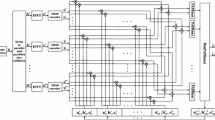Abstract
To solve the low-power-efficiency problem for high peak to average power ratio systems, such as OFDM, an orthogonal inhomogeneous signal decomposition approach is proposed in this paper. The novel method decomposes the signal into branch signals orthogonally, which can adapt to the change of saturate power of each branch power amplifiers. Furthermore, the novel method has the advantages of both high power efficiency of power amplifier and low PAPR of branch signals. Therefore, this is more suitable for practical application. The simulation results indicate that the proposed method can increase the power efficiency remarkably without reducing the BER performance in the receiver.
Similar content being viewed by others
References
Armour S, O’Farrell T, Flectecher S. Green radio: Sustainable wireless network. Engin Technol Mag, 2009. http://kn.theiet.org/magazine/rateit/com-munications/green-radio-article.cfm
Wang J, Chen J. Performance of wideband CDMA with complex spreading and imperfect channel estimation. IEEE J Sel Area Comm, 2001, 19: 152–163
Ryu H-G, Park J S, Park J-S. Threshold IBO of HPA in the predistorted OFDM communication system. IEEE Trans Broadcast, 2004, 50: 425–428
Mann S, Beach M, Warr P, et al. Increasing the talk-time of mobile radios with efficient linear transmitter architectures. Electron Commun Eng J, 2001, 13: 65–76
Ochiai H. Amplifier efficiencies of OFDM systems with peak power and envelope variance reduction. In: IEEE International Symposium on Signal Processing and Information Technology, Vancouver, BC, 2006. 828–833
Ren Z Y, Zhang H L, Guo K. A novel method for the improvement of power efficiency in high peak-to-average power ratio communication systems. Sci China Inf Sci, 2010, 53: 1697–1702
Chipps S C. RF Power Amplifiers for Wireless Conmmunication. 2nd ed. Norwood MA: Artech House, 1999. 100–102
Vuolevi J, Manninen J, Rahkonen M. Measurement with characterizing memory effects in RF power amplifiers. IEEE Trans Microw Theory Tech, 2001, 49: 257–260
Wright A S, Durtler WG, Teltech M, et al. Experimental performance of an adaptive digital linearized power amplifier. IEEE Trans Veh Technol, 1992, 41: 395–400
Jardin P, Baudoin G. Filter lookup table method for power amplifier linearization. IEEE Trans Veh Technol, 2007, 56: 1076–1087
Jones A E, Wikinson T A, Barton P S K. Block coding scheme for the reduction of peak to mean envelope power ratio of multicarrier transmission schemes. Electron Lett, 1994, 30: 2098–2099
Author information
Authors and Affiliations
Corresponding author
Rights and permissions
About this article
Cite this article
Ren, Z., Li, Y., Zhang, H. et al. A high power efficiency method using orthogonal signal decomposition in high PAPR system. Sci. China Inf. Sci. 56, 1–7 (2013). https://doi.org/10.1007/s11432-012-4664-x
Received:
Accepted:
Published:
Issue Date:
DOI: https://doi.org/10.1007/s11432-012-4664-x




